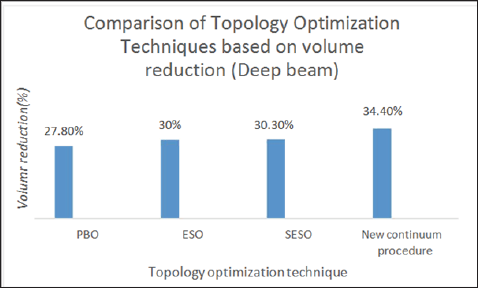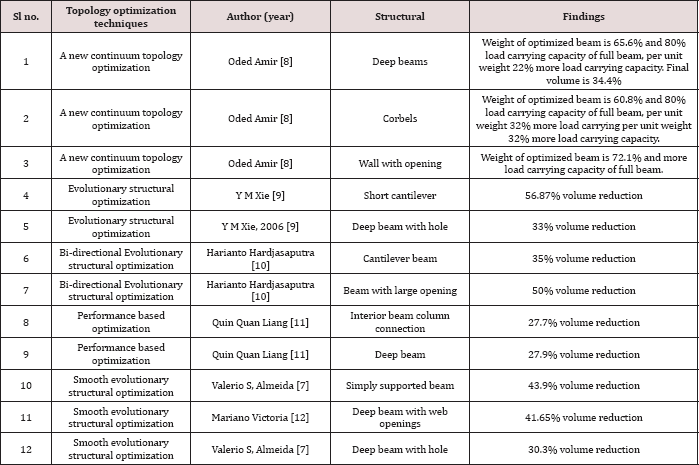
Lupine Publishers Group
Lupine Publishers
Menu
ISSN: 2637-4668
Review Article(ISSN: 2637-4668) 
Critical Reviews on Topology Optimisation of Reinforced Concrete Volume 1 - Issue 5
Sreevidya V* and Nidhi M
- Department of Civil Engineering, Federal Institute of Science and Technology, India
Received: March 27, 2018; Published: April 03, 2018
Corresponding author: Sreevidya V, Department of Civil Engineering, Federal Institute of Science and Technology, Kerala Technological University, Ernakulam, Kerala, India
DOI: 10.32474/TCEIA.2018.01.000124
Abstract
Current demand on resources have forced engineering sector to look at more efficient design and construction methods. Methods that will yield better designs that are cost effective and put less demand on decreasing resources. This study introduces applications of structural topology optimization to reinforced concrete structures. Structural topology optimization is a technique for finding the optimum material layout. Aerospace and automotive engineers routinely employ topology optimization and have reported significant structural performance gains as a result. Recently designers of buildings and structures have also started investigating the use of topology optimization, for the design of efficient and aesthetically pleasing developments. The main objective is to achieve a reduction in the weight of concrete structures. This is motivated by the need to reduce cement production which is a major source of CO2 emissions. Using this engineer can find the best concept design that meets the design requirements. In this paper a critical review on topology optimization of reinforced concrete structures are investigated based on different topology optimization techniques.
Keywords: Topology optimization; Critical Review
Introduction
Structural optimization is concerned with maximizing the utility of a fixed quantity of resources to fulfill a given objective. Three categories of structural optimization exist; shape, size and topology. Structural topology optimization is the most general of the three categories yielding information on the number, location, size and shape of openings within a continuum. The first solutions to a topology optimization problem were presented by Michell [1]. Modern topology optimization techniques can be applied to generalized problems through the use of the Finite Element (FE) method, as a relatively recent innovation. Aerospace, automotive and mechanical engineers have successfully utilized topology optimization in order to achieve weight savings in structures. Enthusiasm for topology optimization in the field of civil/structural engineering, where weight savings are seen as less critical due to the one off nature of building structures, is generally accepted as being more muted. Topology optimization has found several novel applications in the field of civil engineering, most notably; a novel technique for geotechnical analysis and reinforcement layout optimization in concrete structures. The main focus of this review study is applications of topology optimization to reinforced concrete structures.
Topology Optimization Techniques
Topology optimization involves the determination of features such as the number, location and shape of holes and the connectivity of the domain [2].
Homogenization method
In their ground breaking paper, Bendsoe et al. [3] presented the homogenization method. Subsequent research on the field of structural topology optimization has been on the basis of their work. The homogenization method works on the basis of replacing materials in a composite domain with a kind of equivalent material model. This is done because "even with the help of highspeed modern computers, the analysis of the boundary value problems consisting of composite media with a large number of heterogeneities is extremely difficult" [4]. Such a procedure is called homogenization. It is assumed that the design domain is made of periodic microstructures, hence this type of materials are called composites with periodic microstructures.
Simp method
The SIMP (Solid Isotropic Microstructures with Penalization) was proposed by Bendsoe (1989) which he called the direct approach method. The basic concept of SIMP method is that "grey" elements are penalized and removed from the domain to obtain a black (ρ = 1) and white (ρ = 0) topology. That is any element that has density within 0 < ρ < 1 is removed from the design domain. It is assumed that the domain is made of an artificial material and its density can be related to structures stiffness by the following power law [3].
Evolutionary structural optimization (ESO)
The Evolutionary Structural Optimization (ESO) method was proposed by Xie & Steven [5]. The basic idea of the method is that inefficient elements are removed from the design domain based on a material removal criterion. Such a criterion function or parameter value is calculated for each element and in each iteration some elements with the lowest criterion value that do not meet the minimum criterion set are eliminated [6]. By progressively removing such elements the structure will evolve towards an optimum.
Bi-directional evolutionary structural optimization (BESO)
Two major deficiencies present in early versions of ESO method was solution time and uniqueness [5]. Since elements were only removed in the ESO method, it was questioned if the method ensured that it was not a local optimum solution that was obtained and could the elements removed, be returned. The "Bidirectional Evolutionary Structural Optimization" method presented by Querin et al. [5] provided an improved version of the ESO algorithm. The improved method was able to remove inefficient material to eliminate low stress as well as add materials to efficient areas to alleviate high stress.
The element efficiency in BESO is measured the same way as in ESO but the adding and removing uses a different procedure. A control parameter named "Inclusion Ratio" is used to control the amount of material that is added. When no more elements is removed or added that is at steady state, the inclusion ratio is decreased and the rejection ratio is increased.
Performance-based optimization (PBO)
The PBO method combines the topology and sizing optimization into a single scheme to achieve the optimal topology and thickness design of continuum structures. The performance of the structure is the objective criteria for the method that is it uses realistic performance criteria. These performance criteria include structures stiffness, strain, shear, etc.
Smooth evolutionary structural optimization (SESO)
It is a variant of ESO. Here the elements are removed smoothly [7-12]. Here the element with lowest Von Mises stress is calculated for element removal. He demonstrated that SESO can be used for problems containing nonlinearities, dynamic analysis etc.
Topology Optimization of Reinforced Concrete Structures
There are many researchers who have concentrated on topology optimization of reinforced concrete structures. After going through a critical review of this literature, the following findings are made and are given in Table 1. The volume reduction of deep beam using different topology optimization techniques are compared shown in Figure 1.
Figure 1: Comparison of techniques.

Table 1.

Conclusion
The main goal of topology optimization is to achieve a reduction in the weight of concrete structures. This is motivated by the need to reduce cement production which is a major source of CO2 emissions.
a. The volume reduction is more in SESO technique as compared to ESO technique (10.9%) in the case of deep beam with hole.
b. The new procedure developed by Oded Amir the volume reduction is more as compared to all other techniques.
c. In case of wall with opening the load carrying capacity is more in optimized wall than whole wall.
d. In performance based optimization the volume reduction is small compared to other techniques (27.7% in interior beam column connection and 27.8% in bridge pier)
e. The new procedure developed by Oded Amir, suggests bigger potential to topology optimization.
f. Another motivating factor of topology optimization is the growing interest within the architectural community in topology optimization as means of generating aesthetic and efficient structural forms.
References
- Michell AGM (1904) The limits of economy of frame structures. Philosophical Magazine sect 6(8): 589-597.
- Bendsoe MP and Sigmund O (1999) Material interpolation schemes in topology optimization. Archive of Applied Mechanics 69(9-10): 635654.
- Bendsoe MP, Kikuchi N (1988) Generating optimal topologies in structural design using a homogenization method. Computer Methods in Applied Mechanics and Engineering 71(2): 197-224.
- Hassani B, Hinton E (1998) A review of homogenization and topology optimization I homogenization theory for media with periodic structure. Computers & Structures 69(6): 707-717.
- Querin OM, Steven GP, Xie YM (1998) Evolutionary structural optimization (ESO) using a bidirectional algorithm. Engineering Computations 15(8): 1031-1048.
- Rozvanny GIN (2009) A critical review of established methods of structural topology optimization. Structural Multidisciplinary Optimization 37(3): 217-237.
- Valério S Almeidaa, Helio LuizSimonetti, Luttgardes Oliveira Netoc (2013) comparative analysis of strut and tie models using smooth evolutionary structural optimization. Engineering structures 56: 16651675.?
- Oded Amir (2013) Topology Optimization Procedures for Reinforced Concrete structures. computers and structures 114-115: 46-58.
- Xie YM, Steven GP (1993) A simple evolutionary procedure for structural optimization. Computers and Structures 49(5): 885-896.
- Harianto Hardjasaputra (2015) Evolutionary structural optimization as tool in finding strut and tie models for designing reinforced concrete deep beam, The 5th international conference of Euro Asia Civil Engineering 125: 995-1000.
- Liang QQ, Uy B, Steven GP (2002) Performance based optimization for struttie modelling of structural concrete. Journal of structural Engineering 128(6): 815-823.
- Mariano Victoria (2011) Generation of strut and tie models by topology design using different properties in tension and compression 44(2): 247-258.

Top Editors
-

Mark E Smith
Bio chemistry
University of Texas Medical Branch, USA -

Lawrence A Presley
Department of Criminal Justice
Liberty University, USA -

Thomas W Miller
Department of Psychiatry
University of Kentucky, USA -

Gjumrakch Aliev
Department of Medicine
Gally International Biomedical Research & Consulting LLC, USA -

Christopher Bryant
Department of Urbanisation and Agricultural
Montreal university, USA -

Robert William Frare
Oral & Maxillofacial Pathology
New York University, USA -

Rudolph Modesto Navari
Gastroenterology and Hepatology
University of Alabama, UK -

Andrew Hague
Department of Medicine
Universities of Bradford, UK -

George Gregory Buttigieg
Maltese College of Obstetrics and Gynaecology, Europe -

Chen-Hsiung Yeh
Oncology
Circulogene Theranostics, England -
.png)
Emilio Bucio-Carrillo
Radiation Chemistry
National University of Mexico, USA -
.jpg)
Casey J Grenier
Analytical Chemistry
Wentworth Institute of Technology, USA -
Hany Atalah
Minimally Invasive Surgery
Mercer University school of Medicine, USA -

Abu-Hussein Muhamad
Pediatric Dentistry
University of Athens , Greece

The annual scholar awards from Lupine Publishers honor a selected number Read More...













